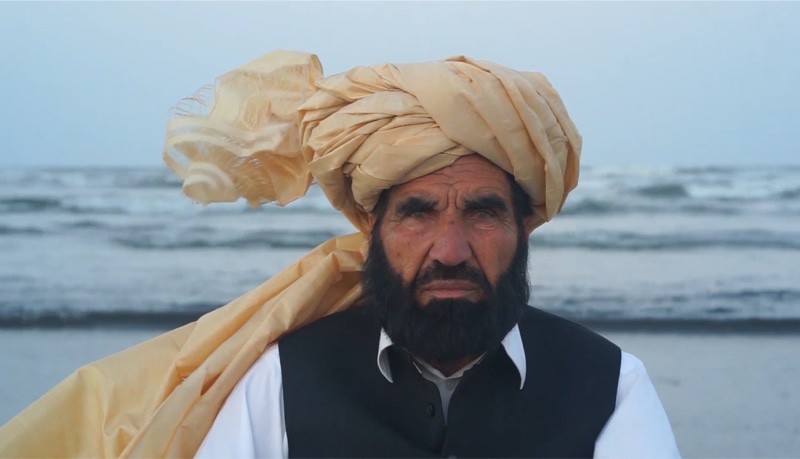The Karachi Biennale, KB19, recently showcased the work of 98 local and international art practitioners held across seven public locations in the city. The biennale incorporates the idea of an extensive art exhibition showcased in the public sphere in order to communicate with new audiences. The theme of this second edition “focuses on the loss of low-flying birds, wiped out by vertical structures in Karachi, giving way to a jungle of tar and concrete, ruled not by the laws of nature, but the toxins of industrial might and greed-based urban planning.”
The main venue, Bagh Ibn-i-Qasim, displayed an ambitious number of about 50 artists’ works in the form of installations, interactive performances, film, paintings and sculptures. A large part of the artworks is displayed under the Lady Lloyd Pier, and extending well into the open space. Curator Mohammad Zeeshan has done well not to disrupt the natural ambience. Site-specificity is a much studied aspect of biennales globally, because it allows the social, historical as well as political contexts to engage with the art. Here, the colonial context of the pier and the Kothari Parade, the adjacent Hindu temple, the shrine of Abdullah Shah Ghazi, as well as the garish new Icon Tower form a strong social and political construct for the work to be viewed in.
Two main aspects of the exhibition emerge at the Bagh. First, artworks such as Hamra Abbas’ ‘Gardens of Paradise’, a 12-foot marble cube, reveals itself gradually as the viewer moves closer to it. Abbas has used an indigenous technique of marble inlay, called parchin kari, to create the imagery of trees on each side. She references the olive, fig, date and pomegranate trees, creating her version of the Islamic Chahar Bagh, or fourfold garden configuration. Her depiction of trees cited in religious scripture stands in strong contrast to the lack of indigenous shade or fruit-bearing trees in the park that has been held hostage to political greed of the land mafias and local municipalities.
The Karachi Biennale proved to be a disappointing case of policing art by the very municipalities which were supposed to foster dialogue on public art
Second, R.M. Naeem’s installation on the upper walkway of the pier, titled ‘Open to the Sky’, stretches in all its physicality well beyond the viewer’s gaze. Naeem has used tonnes of red and green chillies under the sun, as they are sun-dried in the interior of the province, to construct a semblance of mass graves. They say that if you speak between the lines, you can get away with murder, as the authorities have no problem with this particular depiction of graves. However, there is a problematic and jarring sense of spectacle in this design-based installation.

However, sculptor Adeela Suleman’s construction of 444 graves in her installation ‘The Killing Fields of Karachi’, in and outside the colonial Frere Hall, became the site of discontent, vandalism, censorship and protest.
Suleman re-imagines and narrates the investigation into former SSP Rao Anwar’s “fake” police encounters as a sculptor and has been referencing violence in her practice for over a decade. Ironically, it did not strike the Biennale Trustees or the curator, that the real discursive space was unfolding right before them, when Suleman’s work was sealed and removed from sight by the authorities.
Moreover, the mega installations of the most celebrated Pakistani artists, Rashid Rana and Imran Qureshi, in the main hall of the Frere Hall were also sealed off by the enraged authorities. It left many wondering what it means to protest this violation of human rights, as well as of the policing of art by the same municipality and Biennale Trust that are supposedly fostering the art in public venues. The viewing of Suleman, Rana and Qureshi’s works has moved on to YouTube, as has the discussion. Online, the audiences are not the locals and select invitees of the KB, but mainstream world media organisations of human rights and famous museums.
Qureshi’s installation titled, ‘A Garden Within’, consists of thousands of pieces of crumpled paper with printed foliage of his drawings. The work mirrors the dust and mildew destroying the priceless books and periodicals in the Frere Hall library with no working lighting system on the ground floor. Qureshi spoke about recycling the paper to donate to schools in low-income localities, but there is a higher chance that the mounds of paper may now find home on a landfill site or a dumpster.

And what could be more telling than the image in Rana’s video montage titled ‘Beauty Lies’ (2019) Rana is filmed standing atop of what seems like the world’s biggest dumping site, located on the outskirts of Karachi. Perhaps, the city government could not risk the audience watching the artist scrutinising the site of their own failure in managing Karachi’s garbage disposal.
There are many more issues and artworks that cannot be discussed here due to space constraints. If the Biennale Trust is to survive in the future and play a proactive role in influencing a genuine dialogue, it has to empower the curator and to accommodate individuals to resist the pressures from governmental bodies. But most of all, it needs to stand with the artists.
Published in Dawn, EOS, November 17th, 2019















































Dear visitor, the comments section is undergoing an overhaul and will return soon.